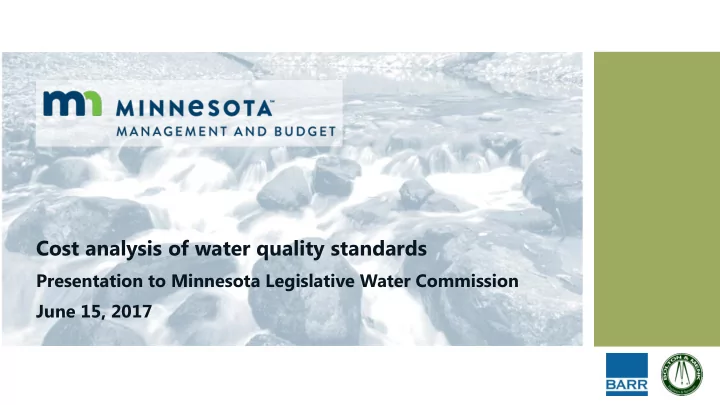

Cost analysis of water quality standards Presentation to Minnesota Legislative Water Commission June 15, 2017
Study purpose and scope Engineering analysis to determine community costs related to compliance with current and future water quality regulations
Study purpose and scope Request from legislature Water quality standards investigated 1. Study representative sample of • Total suspended solids at least 15 communities • Chloride 2. Estimate costs to upgrade • Nutrients (phosphorus and infrastructure to meet current/ nitrogen) future water quality standards • Nitrate (future) 3. Estimate incremental change in • Sulfate (future) water quality resulting from upgrades • Ammonia (current/future)*
1. Study diverse, representative sample of communities
Methodology 25 facilities evaluated 1. Identified applicable current/future water quality standards 2. Gathered data about facilities/water bodies and calculated effluent limits 3. Evaluated which wastewater treatment technologies would be needed to meet Primary selection limits criteria: willingness to participate 4. Estimated costs for wastewater treatment facility upgrades to meet current and proposed standards (15 facilities) Cost estimates — 15 facilities
• Evaluated stormwater infrastructure and costs Methodology required to meet water quality standards (continued) • Examined incremental downstream water quality impacts of: Implementing recommended wastewater infrastructure upgrades (25 facilities) Implementing recommended stormwater infrastructure upgrades (6 cities)
Case study locations Types of analyses Stormwater and wastewater cost analysis, effluent limits and water quality effect Wastewater cost analysis, effluent limits, and water quality effect Effluent limits and water quality effect
2. Estimate infrastructure upgrade costs to meet current/future water quality standards
Number of cities with new or more stringent limits
Three types of treatment Pond Secondary Membrane System Treatment Filtration Total suspended Total suspended Total suspended solids solids solids Some phosphorus Phosphorus Phosphorus Some ammonia Ammonia Ammonia Nitrate Nitrate Chloride Sulfate
Annual increases in user costs for upgrades Upgrades to meet current water Upgrades to meet proposed water quality standards quality standards 2014 dollars per equivalent residential unit Max Avg. Min.
Affordability AFFORDABILITY: Annual sewer cost ≤ 1.4% index of median household income The Minnesota Public Facilities Authority offers grants for wastewater projects when the annual sewer cost to each household exceeds 1.4% of median household income. The Minnesota Pollution Control Agency refers to this value as the “affordability index.”
Existing sewer rates as percentage of median household income Pond system Secondary treatment
Estimated sewer rates with upgrades to meet current water quality standards (percentage of median household income) Secondary treatment Membrane treatment Pond system 1.4%
Estimated sewer rates with upgrades to meet future water quality standards (percentage of median household income) Secondary Membrane treatment treatment Pond system 1.4%
Anticipated • Existing rates in 15 cities studied: 0.6−2.6% sewer rates of median household income • Rates following upgrades to meet current Affordability water quality standards: 1.1−4.9% index = ≤ 1.4% • Sewer rates following upgrades to meet of median future water quality standards: 1.1−5.2% household income Increased pressure on funding sources
Percentage of cities meeting affordability index of 1.4% of median household income Wastewater project • Existing conditions affordability for cities evaluated • Upgrades to meet current standards • Upgrades to meet future standards
3. Stormwater costs and estimate incremental change in water quality resulting from wastewater treatment and stormwater upgrades
Existing pollutant loads (metric tons per year) Stormwater costs and pollutant load Wet detention ponds reductions $15 million annualized total cost for six municipal separate storm sewers Existing reductions Existing reductions Future reductions Future 50% total reductions phosphorus 30% total reduction nitrogen 85% total reduction suspended solids reduction
Pollutant reduction in wastewater treatment facility discharge resulting from upgrades to meet effluent limits from current water quality standards Percent reduction in pollutant concentration or loading
Pollutant reduction in wastewater treatment facility discharge resulting from upgrades to meet effluent limits from future water quality standards
Total pollutant load reductions by major river basin (metric tons per year) Total Phosphorus Total Nitrogen Mississippi Mississippi River River Lake Lake Winnipeg Winnipeg Lake Superior Lake Superior Solids Lake Winnipeg Basin Mississippi River Lake Superior Lake Basin Winnipeg Wastewater Mississippi Lake Superior Stormwater River Basin
Overall cost for wastewater/stormwater system upgrades Wastewater (dollars per year/equivalent residential unit) Wastewater Stormwater Stormwater (dollars per year/acre of impervious area)
Questions? Engineering Cost Analysis of Current and Recently Adopted, Proposed, and Anticipated Changes to Water Quality Standards and Rules for Municipal Stormwater and Wastewater Systems in Minnesota Prepared for Minnesota Management and Budget https://mn.gov/mmb-stat/documents/budget/barr-engineering-cost-of-water-quality-standards-report.pdf
Anticipated • Existing rates in 15 cities studied: 0.6−2.6% sewer rates of median household income • Rates following upgrades to meet current Affordability water quality standards: 1.1−4.9% index = ≤ 1.4% • Sewer rates following upgrades to meet of median future water quality standards: 1.1−5.2% household income Increased pressure on funding sources
Nitrogen and phosphorus loading reductions to major basins due to current/future wastewater treatment facility effluent limits Percent Mass Reduction Standards Reduction (Metric Tons/Year) Lake Superior Basin Loading Summary Lake Winnipeg Basin Total nitrogen — current 0.0% 0 Total nitrogen — proposed 14.4% 697 Lake Superior Total phosphorus — current 0.0% 0 Basin Lake Winnipeg Basin Loading Summary Total nitrogen — current 0.8% 45 Total nitrogen — proposed 1.0% 58 Total phosphorus — current 0.8% 1.2 Mississippi River Basin Mississippi River Basin Loading Summary Total nitrogen — current 0.1% 122 Total nitrogen — proposed 1.2% 1,623 Total phosphorus — current 1.2% 27
Recommend
More recommend